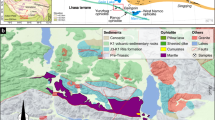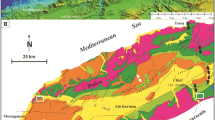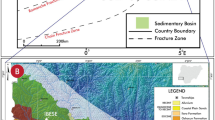Abstract
“Lo Hueco” (Cuenca, Spain) is an upper Campanian–lower Maastrichtian Fossil-Lagerstätte that has provided more than 8,500 well-preserved macrofossils, including titanosaur sauropod dinosaurs. Although the facies and fossil record point to both fresh and brackish or marine water influences, a detailed study of the sulphate-bearing layers of the site through petrography, fluid inclusions, and isotopes has been undertaken to evaluate the possible marine influence. The two main sulphate units of the “Lo Hueco” site consist chiefly of bimodal micro- to meso- lenticular gypsum crystals that grew displacively in a clayey-carbonate sediment. The well-preserved lenticular gypsum crystals are primary, as demonstrated by the presence of the original twinning and the absence of hydration textures or anhydrite relicts. Primary fluid inclusions of the lenticular gypsum crystals indicate a vadose environment of formation, with salinities between 1,800 and 14,000 ppm, pointing to a brackish but non-marine environment. Furthermore, gypsum exhibits 87Sr/86Sr values between 0.708034 and 0.708120, which are higher than those from marine evaporites of Campanian–Maastrichtian age, indicating a clear influence of fresh water. Gypsum δ 34S VCDT values (18.1 to 19.0 ± 0.5 ‰) and δ 18OVSMOW values (11.0 to 15.2 ± 0.5 ‰), on the other hand, are typical isotopic values recorded in marine evaporites of this age. This apparent contradiction between fluid inclusion and Sr isotopic data is probably the result of some recycling from Upper Cretaceous evaporites. Based on all these observations, the sulphate-bearing layers are interpreted as probably formed in a near-coastal saline mudflat of a playa lake. As a whole, this study highlights the importance of combining different proxies when dealing with evaporites formed in brackish-water environments.









Similar content being viewed by others
References
Albert-Colomer V, Ferreiro-Padín E (1998) Explicación de la Hoja de San Lorenzo de la Parrilla, 634 (23–25). Mapa Geológico de España 1:50000. Segunda Serie. Instituto Geológico y Minero de España
Ali YA, West I (1983) Relationship of modern gypsum nodules in sabkhas of loess to composition of brines and sediments in northern Egypt. J Sediment Petrol 53(4):1151–1168
Arenas C, Casanova J, Pardo G (1997) Stable-isotope characterization of the Miocene lacustrine systems of Los Monegros (Ebro Basin, Spain): paleogeographic and paleoclimatic implications. Palaeoclimatol Palaeoecol 128:133–155
Barroso-Barcenilla F, Cambra-Moo O, Escaso F, Ortega F, Pascual A, Pérez-García A, Rodríguez-Lázaro J, Sanz JL, Segura M, Torices A (2009a) New and exceptional discovery in the Upper Cretaceous of the Iberian Peninsula: the palaeontological site of “Lo Hueco”, Cuenca, Spain. Cretaceous Res 30:1268–1278
Barroso-Barcenilla F, Cambra-Moo O, Carenas B, Coruña F, Domingo L (2009b) First mineralogical and geochemical overview and interpretation of “Lo Hueco” vertebrate site (Upper Cretaceous, Cuenca, Spain). J Vertebr Paleontol 29(Supplement to 3):59
Barroso-Barcenilla F, Cambra-Moo O, Segura M (2010) Estudio preliminar sobre Geología y Tafonomía del yacimiento paleontológico de “Lo Hueco” (Cretácico Superior, Cuenca, España). Bol R Soc Esp Hist Nat Sec Geo 104:57–70
Bodnar RJ (1993) Revised equation and table for determining the freezing point depression of H2O–NaCl solutions. Geochim Cosmochim Ac 57:683–684
Burke WH, Denison RE, Hetherington EA, Koepnick RB, Nelson HF, Otto JB (1982) Variation of seawater 87Sr/86Sr throughout Phanerozoic time. Geology 10:516–519
Callapez P, Barroso-Barcenilla F, Cambra-Moo O, Segura M (2013) Molluscs from the fossil site of “Lo Hueco” (Upper Cretaceous, Cuenca, Spain): palaeoenvironmental and sequential implications. Estudios Geológicos. doi:10.3989/egeol.41148.244
Cambra-Moo O, Barroso-Barcenilla F, Berreteaga A, Carenas B, Coruña F, Domingo L, Domingo MS, Elvira A, Escaso F, Ortega F, Pérez-García A, Peyrot D, Sanz JL, Segura M, Sopelana A, Torices A (2012) Preliminary taphonomic approach to “Lo Hueco” palaeontological site (Upper Cretaceous, Cuenca, Spain). Geobios 46:157–166
Cambra-Moo O, Barroso-Barcenilla F, Coruña F, Postigo-Mijarra JM (2013) Exceptionally preserved vegetal remains from the Upper Cretaceous “Lo Hueco” site, Cuenca, Spain. Lethaia 46:127–140
Carenas B, Barroso-Barcenilla F, Berreteaga A, Cambra-Moo O, Coruña F, González-Acebrón L, Segura M (2011) First overview on gypsum in the new and exceptional “Lo Hueco” fossil site, (Upper Cretaceous, Cuenca, Spain). In: Sampson DH (ed) Gypsum: properties, production and applications. Nova Publishers, New York, pp 176–190
Claypool GE, Holser WT, Kaplan YR, Sakai H, Zak I (1980) The age of sulfur and oxygen isotopes in marine sulfate and their mutual interpretation. Chem Geol 28:199–260
Coruña F, Barroso-Barcenilla F, Cambra-Moo O (2011) Clay mineral characterization of “Lo Hueco” fossil site (Upper Cretaceous, Cuenca, Spain). Abstracts of the Euroclay 2011 Conference, p 247
D’Alessandro A, Bromley RG (1987) Meniscate trace fossils and the Muensteria-Taerudium problem. Palaeontology 30:743–776
Domingo L, Barroso-Barcenilla F, Cambra-Moo O (2013) Palaeoenvironmental reconstruction of the “Lo Hueco” fossil site (Upper Cretaceous, Cuenca, Spain): preliminary stable isotope analyses on crocodilians and dinosaurs. Palaios 28:195–202
Forte GL, Ortí F, Rosell L (2005) Isotopic characterization of Jurassic evaporites. Aconcagua-Neuquén Basin, Argentina. Geologica Acta 3:155–161
Frey RW, Pemberton SG (1984) Trace fossil facies models. In: Walker RG (ed) Facies models. Geoscience Canada Reprint, Series 1, Geological Association of Canadá, Toronto, pp 189–207
García A, Segura M, García-Hidalgo JF, Carenas B (1993) Mixed siliciclastic and carbonate platform of Albian-Cenomanian age from the Iberian Basin (Spain). In: Simo T, Scott BW, Masse JP (eds) Cretaceous carbonate platforms. AAPG Memoir 56, American Association of Petroleum Geologists, Tulsa, pp 255–269
García-Hidalgo JF, Barroso-Barcenilla F, Gil J, Martínez R, Pons JM, Segura M (2012) Stratal, sedimentary and faunal relationships in the Coniacian 3rd order sequence of the Iberian Basin (Spain). Cretaceous Res 34:268–283
Gil J, Carenas B, Segura M, García-Hidalgo JF, García A (2004) Revisión y correlación de las unidades litoestratigráficas del Cretácico Superior en la región central y oriental de España. Rev Soc Geol Esp 17:249–266
Goldstein RH, Reynolds TJ (1994) Systematics of fluid inclusions in diagenetic minerals. SEMP Short Course 31, SEPM, Tulsa
González-Acebrón L, Barroso-Barcenilla F, Cambra-Moo O, Carenas B (2010) Exploratory diagenetic analysis on vertebrate fossils from “Lo Hueco” site (Upper Cretaceous, Cuenca Spain). J Vertebr Paleontol Supplement for the Society of Vertebrate Paleontology LXX Meeting:97–98
Hancock JM (1991) Ammonite scales for the Cretaceous system. Cretaceous Res 12:259–291
Hess J, Bender ML, Schilling JG (1986) Evolution of the ratio of Strontium-87 to Strontium-86 in seawater from Cretaceous to present. Science 231:979–984
Holser WT, Clement GP, Jansa LF, Wade JA (1988) Evaporite deposits of the North Atlantic rift. In: Masspeizer W (ed) Triassic-Jurassic rifting. Continental breakup and the origin of the Atlantic Ocean and passive margins, Part B, Elsevier, Amsterdam, pp 526–556
Huerta P, Armenteros I, Recio C, Blanco JA (2010) Palaeogroundwater evolution in playa-lake environments. Sedimentary facies and stable isotope record (Palaeogene, Almazán basin, Spain). Palaeogeogr Palaeoclimatol Palaeoecol 286:135–148
Ingram BL, Sloan D (1992) Strontium isotopic composition of estuarine sediments as paleosalinity-paleoclimate indicator. Science 255:68–72
Land LS (1980) The isotopic and trace element geochemistry of dolomite: the state of the art. In: Zenger DH, Dunham JB, Ethington RL (eds) Concepts and models of dolomitization 28. SEPM Spec Publ, Tulsa, pp 87–110
Land LS (1992) The dolomite problem: stable and radiogenetic isotope clues. In: Chaudhuri NS (ed) Isotopic signature of sedimentary records 43. Lecture notes in Earth Science, pp 49–68
Lendínez-González A, Muñoz del Real JL, Insua-Márquez M (1998) Explicación de la Hoja de Villar de Olalla, 609 (23–24). Mapa Geológico de España 1:50000. Segunda Serie. Instituto Geológico y Minero de España, Madrid
Lindholm RE, Finkelman RB (1972) Calcite staining; semiquantitative determination of ferrous iron. J Sediment Petrol 1:239–245
Lloyd RM (1968) Oxygen isotope behavior in the sulfate-water system. J Geophys Res 73:6099–6110
Lu FH, Meyers WL, Schoonen MA (2001) S and O (SO4) isotopes, simultaneous modeling and environmental significance of the Nijar Messinian gypsum, Spain. Geochim Cosmochim Acta 65:3081–3092
MacLeod KG, Fullagar PD, Huber BT (2003) 87Sr/86Sr test of the degree of impact-induced slope failure in the Maastrichtian of the western North Atlantic. Geology 31(4):311–314
McArthur JM (1994) Recent trends in strontium isotope stratigraphy. Terra Nova 6(4):331–358
McArthur JM, Howarth RJ (2004) Strontium isotope stratigraphy. In: Gradstein F, Ogg J, Smith A (eds) A geological time scale. Cambridge University Press, Cambridge, pp 96–105
McArthur JM, Howarth RJ, Bailey TR (2001) Strontium isotope stratigraphy: lowess version 3: best-fit to the marine Sr-isotope curve for 0 to 509 Ma and accompanying look-up table for deriving numerical age. J Geol 109:155–170
McKenzie J (1981) Holocene dolomitization of calcium carbonate sediments from the coastal sabkhas of Abu Dhabi, UAE: a stable isotope study. J Geol 89:185–198
Meléndez F (1975) Correlación del Cretácico de la Serranía de Cuenca con el del Sondeo de Villanueva de los Escuderos 1 (Cuenca). Actas del I Symposium sobre el Cretácico de la Cordillera Ibérica, pp 85–97
Meléndez-Hevia F (1971) Estudio geológico de la Serranía de Cuenca en relación a sus posibilidades petrolíferas. Ph.D. Thesis. Publicaciones de la Facultad de Ciencias de la Universidad Complutense de Madrid, Madrid
Ortega F, Sanz JL, Barroso-Barcenilla F, Cambra-Moo O, Escaso F, García-Oliva M, Marcos-Fernández F (2008) El yacimiento de macrovertebrados fósiles del Cretácico Superior de “Lo Hueco” (Fuentes, Cuenca). In: Esteve J, Meléndez G (eds) Palaeontologica Nova. Publicaciones del Seminario de Paleontología de Zaragoza 8, Zaragoza, pp 119–131
Ortí F (2000) Unidades glauberíticas del Terciario Ibérico: nuevas aportaciones. R Soc Geol Esp 13:227–249
Ortí F (2010) Evaporitas: introducción a la sedimentología evaporítica. In: Arche A (ed) Sedimentología: del proceso físico a la cuenca sedimentaria. Consejo Superior de Investigaciones Científicas, Madrid, pp 675–769
Paytan A, Kastner M, Campbell D, Thiemens MH (2004) Seawater sulfur isotope fluctuations in the Cretaceous. Science 304:1663–1665
Pérez-García A, Ortega F, Murelaga X (2009) Una probable tortuga Pancryptodira del Cretácico Superior de “Lo Hueco” (Cuenca, España). Paleolusitana 1:365–371
Peyrot D, Barroso-Barcenilla F, Cambra-Moo O (2013) Paleoecology of the late Campanian/early Maastrichtian Fossil-Lagerstätte of “Lo Hueco” (Cuenca, Spain): palynological insigns. Palaeogeogr Palaeoclimatol Palaeoecol 387:27–39
Playà E, Rosell L (2005) The celestite problem in gypsum Sr geochemistry: an evaluation of purifying methods of gypsiferous samples. Chem Geol 221:102–116
Playà E, Cendón DI, Travé A, Chivas AR, García A (2007) Non-marine evaporites with both inherited marine and continental signatures: the Gulf of Carpetania, Australia, at ~70 ka. Sediment Geol 201:267–285
Poyato-Ariza FJ, Talbot MR, Fregenal-Martínez MA, Melendez N, Wenz S (1998) First isotopic and multidisciplinary evidence for non-marine coelacanths and pycnodontiform fishes: paleoenvironmental implications. Palaeogeogr Palaeoclimatol Palaeoecol 144:65–84
Ramírez del Pozo J, Portero JM, Olivé A (1975) Fuentes, 635 (24–25). Mapa Geológico de España 1:50000. Segunda Serie. Instituto Geológico y Minero de España
Ramírez-Merino JA (1989) Explicación de la Hoja de Las Majadas, 587 (24–23) Mapa Geológico de España 1:50000. Segunda Serie. Instituto Geológico y Minero de España, Madrid
Rodríguez-Aranda JP, Calvo JP (1998) Trace fossils and rhizoliths as a tool for sedimentological and palaeoenvironmental analysis of ancient continental evaporite successions. Palaeogeogr Palaeoclimatol Palaeoecol 140:383–399
Salvany JM, Muñoz A, Pérez A (1994) Nonmarine evaporitic sedimentation and associated diagenetic processes of the southwestern margin of the Ebro Basin (lower Miocene), Spain. J Sediment Res 64(A2):190–203
Segura M, García-Hidalgo JF, Carenas B, García A (1993) Upper Cenomanian platform from central Eastern Iberian (Spain). In: Simo T, Scott BW, Masse JP (eds) Cretaceous carbonate platforms. AAPG Memoir 56, American Association of Petroleum Geologists, pp 283–296
Segura M, Polo T, García-Hidalgo JF, Gil J, Carenas B, García A (2006) The Upper Cretaceous in Tagus Basin (Central Spain): sequential analysis based on oil-well data and outcrop correlation. In: Moratti G, Chalouan A (eds) Tectonics of the Western Mediterranean and North Africa. Geological Society, Special Publication, 262, pp 231–244
Strauss H (1997) The isotopic composition of sedimentary sulphur through time. Palaeogeogr Palaeoclim Paleoecol 132:97–118
Thode HG, Monster J (1965) Sulfur isotope geochemistry of petroleum, evaporites, and ancient seas. Am Assoc Pet Geol Mem 4:367–377 (reprinted In: Kirkland DW, Evans R (eds) Marine evaporites: origin, diagenesis, and geochemistry. Dowden, Hutchinson and Ross, Stroudsburg, 1973, pp 363–373)
Tucker ME, Wright VP (1992) Carbonate sedimentology. Blackwell, Oxford
Utrilla R, Pierre C, Ortí F, Pueyo JJ (1992) Oxygen and sulphur isotope compositions as indicators of the origin of Mesozoic and Cenozoic evaporites from Spain. Chem Geol 102:229–244
Vasconcelos C, McKenzie JA, Warthmann R, Bernasconi SM (2005) Calibration of the d18O paleothermometer for dolomite precipitated in microbial cultures and natural environments. Geology 33:317–320
Veizer J, Ala D, Azmy K, Bruckschen P, Buhl D, Bruhn F, Carden GAF, Diener A, Ebneth S, Goddéris Y, Jasper T, Korte C, Pawellek F, Podlaha OG, Strauss H (1999) 87Sr/86Sr, δ 13C and δ 18O evolution of Phanerozoic seawater. Chem Geol 161:59–88
Vilas L, Mas R, García A, Alonso A, Meléndez N, Rincón R (1982) Ibérica Suroccidental. In: García A (ed) El Cretácico de España. Universidad Complutense de Madrid, Madrid, pp 457–508
Warren JK (2006) Evaporites: sediments, resources and hydrocarbons. Springer, Berlin Heidelberg New York, p 1035
Acknowledgments
The authors would like to thank the useful comments and revisions on the manuscript of F. Ortí, M. Moragas, E. Playà, L. Domingo, and M.E. Tucker. Barajas is also thanked for her technical support. Part of this research has been financed and carried out within projects PEII11-0237-7926 of the Junta de Castilla-La Mancha, and CGL2011-25894, CGL2011-227/BTE and CGL2012-35199 of the Ministerio de Economía y Competitividad, Spain.
Author information
Authors and Affiliations
Corresponding author
Rights and permissions
About this article
Cite this article
González-Acebrón, L., Barroso-Barcenilla, F., Cambra-Moo, O. et al. Environmental significance of gypsum-bearing layers at the “Lo Hueco” paleontological site (Upper Cretaceous, Cuenca, Spain): petrography, fluid inclusions, and isotopic relations. Facies 60, 755–771 (2014). https://doi.org/10.1007/s10347-014-0402-8
Received:
Accepted:
Published:
Issue Date:
DOI: https://doi.org/10.1007/s10347-014-0402-8




